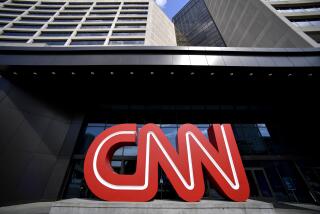The News Broadcast That’s Lasted 20 Years
- Share via
Bernard Shaw was at CNN “before the beginning,” before the all-news, round-the-clock network began on June 1, 1980.
“Critics were saying it would not work. They were wondering if we’d have enough to fill the time, 24 hours a day,” he recalled. “But we interrupted our first commercial to get President Carter on the air. He had just been to the hospital to visit Vernon Jordan, who had been shot. It was breaking news.”
Shaw, Cable News Network’s principal anchor, will be among the journalists participating in two prime-time specials for CNN’s 20th anniversary, Thursday and next Friday at 6 and 9 p.m. each day.
The two-hour programs, hosted by Larry King, will revisit many of the top news events of the past 20 years. King will interview both CNN journalists and newsmakers who were there.
In Washington, “They were literally building the place, room by room and wall by wall,” Shaw said. During one newscast, two painters started talking behind him on the set while he was on the air.
In the beginning, “the atmosphere was tense and filled with anxiety. We were anxious to prove ourselves, to get on the air. . . . The average day was 12 hours. It was expected and we did it.”
CNN initially was criticized for not having perspective and analysis, Shaw said. “But no one can say that now. Look at our political coverage . . . at ‘Crossfire,’ ‘Inside Politics’ and others.”
At first, CNN had an identity problem, he added. “When we went on air, sometimes it was a teeth-pulling operation to get guests. People didn’t know who we were. It took intense effort--daily--to tell people who we were and why they should bother to be on the programs. . . . That battle was won in a relatively short time.”
Frank Sesno, senior vice president and Washington bureau chief for CNN, has been with the cable network for 16 years. “In the beginning, very few listened or watched because very few could see or hear or were connected. Now CNN is listened to,” he said.
When Sesno called the White House in the early days and identified himself as being with CNN, he said, “I used to get, ‘Is this the phone company?’ ”
Sesno would say, “This is Ted Turner’s 24-hour news network,” and found that people recognized Turner’s name.
When Turner launched the network, he had high expectations. “We sign on June 1, and barring satellite problems in the future, we won’t be signing off until the world ends. . . . We will cover it live . . . that’ll be our last event,” he said at the time.
But Turner’s optimism generally was met with skepticism, said Ralph J. Begleiter, who was CNN’s world affairs correspondent from 1981 to 1999 and now teaches journalism and political science at the University of Delaware.
“We were called the ‘Chicken Noodle Network’ back then,” Begleiter said. “And in the first years, it was in doubt whether CNN would succeed. Would anybody watch it? Was there enough money to put it together?” During the first several years, the network lost millions of dollars, Begleiter said.
But CNN had positive cash flow in 1985. Derek Baine of Paul Kagan Associates, a media research firm, said CNN and CNN Headline News last year had revenue of $700 million and cash flow (revenue minus such costs as interest) of $286 million. This year, revenue is projected to be $793 million with cash flow of $346 million, he said.
Shaw said CNN’s credibility and reputation grew over the years. “I don’t think that news has changed, but what CNN has done is changed how news is reported and perceived. Effectively, CNN created news on demand.”
There is what is known as the “CNN effect.” Steven Livingston, associate professor in the school of media and public affairs at George Washington University, said the term describes the “consequences of global, live coverage of crises where you watch what is happening as it happens; the ability for us here to see a battle in the Persian Gulf or the effects of a bombing.”
The ‘CNN Effect’ and Foreign Policy
But critics charge that the “CNN effect” has skewed American foreign policy, Livingston said. “Thus, the U.S. government focuses on the dramatic news rather than on pressing national interests.” This applies not just to CNN but to other media as well, he said. “But CNN was first to create this effect.”
In the past 20 years, Shaw said, there has been no single moment that marked CNN’s acceptance as a network. Among the most memorable events, he said, are the demonstrations at Beijing’s Tiananmen Square, the Persian Gulf War and the Reagan-Gorbachev summit in Washington. Also in Washington, the attempt to assassinate President Reagan in 1981, the crash of Air Florida Flight 90 into the Potomac River in 1982 and President Clinton’s impeachment trial by the U.S. Senate, to name a few.
To Livingston, “the high-water mark was the coverage of the Persian Gulf War in 1991. That’s when CNN came of age . . . and initially it did the story without pictures. The reporters--Bernard Shaw, John Holliman and Peter Arnett--were describing what they were seeing. Ironically, it was like radio--and parallel to Edward R. Murrow’s reports during the London blitz in World War II.”
And the future? “We are in a transitional era now,” Sesno said. “There’s the Internet and a gigantic emerging CNN site. Twenty years is a generation, and we are literally entering the next generation. If we were the real thing then, the Internet site is the real thing times 10.”
More to Read
The biggest entertainment stories
Get our big stories about Hollywood, film, television, music, arts, culture and more right in your inbox as soon as they publish.
You may occasionally receive promotional content from the Los Angeles Times.










